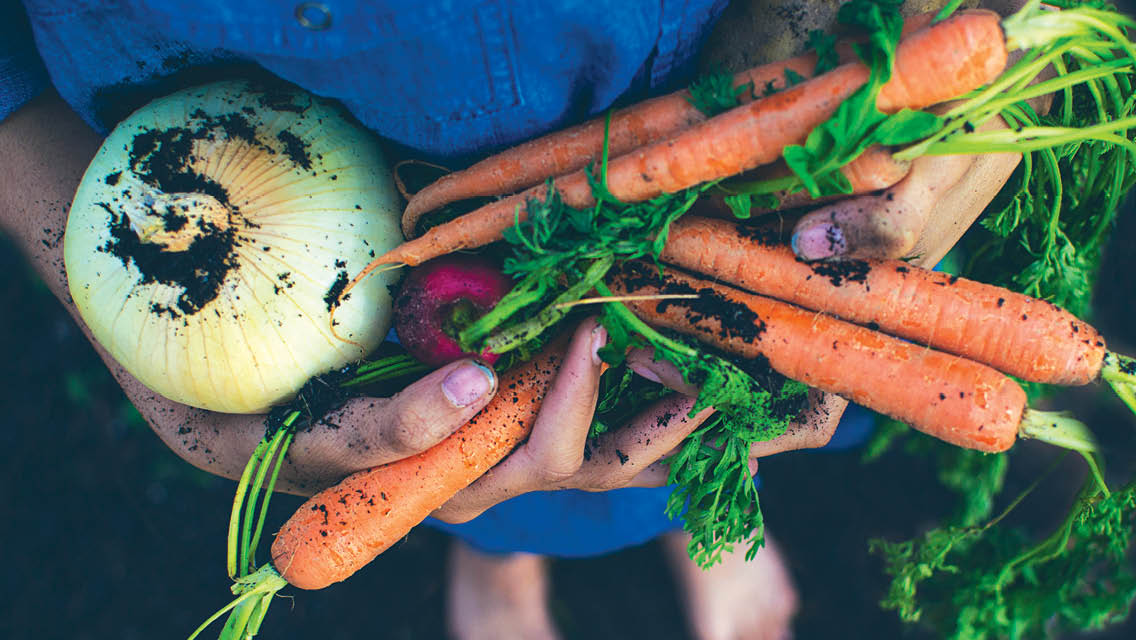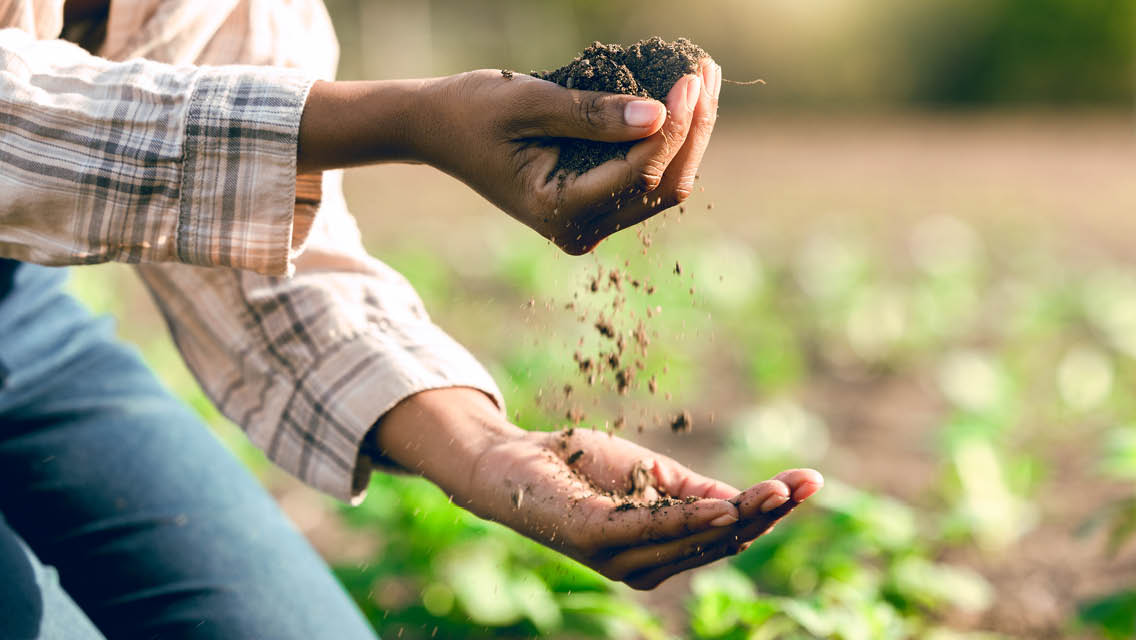You’ve heard the adage “You are what you eat.” That understanding may even motivate you to buy organic produce free of pesticide residue or to seek out foods like grassfed beef or pastured eggs. After all, we are what our food eats, too.
But the wellspring of food quality goes even deeper.
“If we are what our food eats, we are only as healthy as the soil our food is grown in,” writes integrative neurologist Maya Shetreat, MD, in The Dirt Cure.
A small but expanding body of research backs this idea, demonstrating that the health-promoting properties of our food are inextricably tied to the health of the soil.
Soil is not a dead medium. When we treat it with care and respect, it is a vibrant and complex ecology of bacteria, fungi, and other living things — and everything growing in it and eating from it is healthier. Including us.
Where Did the Nutrients Go?
In conventional industrial-farming operations, soil is too often treated like dirt. Now-common practices — the use of synthetic fertilizers, pesticides, and herbicides; tillage; and leaving soil bare for much of the year — fundamentally change the quality of the soil and what’s grown in it.
The nutritional value of many of the vegetables and fruits we eat today is 5 to 40 percent lower than that of the same produce grown 50 to 70 years ago, according to researcher Donald R. Davis, PhD, FACN.
In a study published in the Journal of the American College of Nutrition in 2004, Davis reviewed U.S. Department of Agriculture nutritional data from 1950 and 1999 for 43 different vegetables and fruits. He found “apparent, statistically reliable declines” in the amount of protein, calcium, phosphorus, iron, riboflavin, and vitamin C across the foods he studied over those years.
British researchers conducted a similar analysis in 2021, finding that the amounts of iron, copper, magnesium, and other nutrients in vegetables and fruits had declined between 1940 and 2019. Meanwhile, their water content had increased.
The nutritional value of many of the vegetables and fruits we eat today is 5 to 40 percent lower than that of the same produce grown 50 to 70 years ago.
Scientists think that these nutrient losses stem from conventional farming’s reliance on synthetic fertilizers and plant cultivars bred for high yields instead of for nutrient quality, as well as its many practices that deplete soil health.
Fortunately, other research suggests that more ecosystem-friendly farming can help plants regain their nutritional bounty.
A 2014 paper published in the British Journal of Nutrition summarizes the results of 343 peer-reviewed studies that show significantly higher levels of phytonutrients in crops raised organically — a conclusion that suggests organic farming supports soil health better than industrial techniques do. (For more on this, see “Conventional Farming Practices That Harm the Soil” below.)
In a study published in 2007, scientists at the University of California, Davis, compared levels of flavonoids — phytonutrients that protect against cardiovascular disease, cancer, and dementia — in tomatoes raised organically for 10 years with those raised conventionally during the same time period. They found that the organic tomatoes had much higher levels of two important flavonoids, quercetin and kaempferol, than the conventionally grown tomatoes.
This research is especially interesting because the organic plots produced similar yields to the conventional fields, debunking the notion that farmers must sacrifice quantity for quality.
Another potent nutrient provided by healthy soils full of microorganisms is L-ergothioneine (ERGO). Some refer to this antioxidant and anti-inflammatory amino acid as the “longevity vitamin” for its potential to stem the chronic diseases of aging. In a 2021 study, scientists from Penn State University showed that the intensive tillage of industrial agriculture decreases the concentration of ERGO in three different crops.
Many farmers who start their careers with an industrial mindset discover that it leaves their land less resilient, and often less productive, so they turn toward regenerative agriculture — a set of practices that enhance soil health. Geomorphologist David Montgomery, PhD, and biologist Anne Biklé, MLA, coauthors of What Your Food Ate: How to Heal Our Land and Reclaim Our Health, worked with some of these farming visionaries on studies comparing food from regenerative farms with food from conventionally managed farms. They found that the regenerative farms produced crops with higher levels of phytochemicals, vitamins, and minerals.
One of the studies found that the meat from animals raised on regenerative pastures — where farmers paid attention to building soil health — contained higher levels of healthy omega-3 fatty acids than meat from animals raised either conventionally or on pasture where soil health wasn’t a priority.
Despite mounting evidence linking healthy soil and healthy plants — and showing how industrial agriculture can disrupt and destroy ecosystems — research into the connection between healthy soil and healthy humans is still in its infancy.
“Some of this has to do with the complexities and many unknowns involved in the research,” explains Kristine Nichols, PhD, lead soil scientist at the Food Water Wellness Foundation. “Some of it has to do with how new this area of research is, and some is due to a lack of financial support and the costs involved.”
Most food and agriculture research is funded by companies hoping to promote their commercial farming products, so funds are not flooding in for research examining whether fewer chemical products and more knowledge of nature would benefit our agriculture and health.
Why Healthy Soil Matters
There are more life forms in a teaspoon of healthy soil than there are humans on the planet, and scientists are still in the exciting early stages of discovering just how these microorganisms interrelate with plants — and with us.
What has emerged from the research is evidence of an ongoing barter between plants and the soil’s most miniscule residents. Through the solar-powered energy-conversion process of photosynthesis, plants create a sugary carbon fuel that supports their own growth. But they don’t use it all: 40 percent or more of this fuel is streamed through their roots, delivering energy to fungi and other microorganisms in the earth.
In exchange, these microorganisms feed plants the mineral nutrients they extract from rock, sand, silt, and clay within the soil.
There are more life forms in a teaspoon of healthy soil than there are humans on the planet.
The relationship gets even more complicated. Just as we humans depend upon our microbiome for multiple benefits, plants rely on the soil’s microbiome to help defend against pests, increase availability of nutrients, and more.
Interestingly, in soils with lots of biodiversity, you’ll find some microbes that are closely related to disease organisms, explains Utah State University soil scientist Jennifer Reeve, PhD. These microbes don’t cause disease, but the plants produce compounds in response to them.
In doing so, they develop a robust set of defenses — just in case the microbes’ disease-causing cousins come along. Not only will these plants be able to fight off disease better than those grown in depleted soil, but they can also offer a richer array of phytonutrients to the humans who eat them.
“Plants can’t run away, so they have evolved this huge arsenal of different chemical compounds to protect them against pests, disease, and UV and water stress,” says Reeve. “Many of these chemicals and phytonutrients have been shown to have beneficial activity in human health.”
Soil-Friendly Livestock
Grazing and foraging animals play a role in this dynamic ecology as well. “The meat, eggs, and milk from animals raised on pasture are higher in nutrients than those from animals raised in confinement,” explains Rutgers University soil scientist Joseph R. Heckman, PhD.
Heckman tested soils in the mid-Atlantic states and found that samples from pastures were 60 percent higher in organic matter than those in cropland without animals. “Having those animals on the land is also the best way to build soil quality.”
“Nature never farms without animals,” adds Didi Pershouse, founder of the Land and Leadership Initiative and author of The Ecology of Care: Medicine, Agriculture, Money, and the Quiet Power of Human and Microbial Communities. “That’s everything from earthworms up to grazing animals.”
Even livestock like cattle can benefit the soil, as long as they’re managed in such a way as to prevent heavy grazing that kills plants. They deposit microbe-rich urine and dung, and they cause plants to pulse carbon sugars into the soil ecosystem.
There’s a virtuous cycle when animals are brought onto the land: They make the soil healthier, which makes the plants healthier, which makes the animals themselves healthier — and those health benefits are passed on to humans.
Like soil, animals, and plants, humans are complex biological systems. As we seek out food that nourishes us, we would do well to consider that our health is deeply connected to the biological systems that produce it. From the ground up.
7 Ways to Find Food From Good Soil
Some food and farm activists want to see an official “soil health” label — much like the federally regulated organic label — but for now, nothing like this exists to guide consumers. Finding food grown in good soil requires some detective work. Experts offer these clues.
1) Buy organic or regenerative organic when possible. Paying extra for certified organic food will protect you from most pesticide, herbicide, and fertilizer residue, as well as from subtherapeutic antibiotics in meat and bioengineered crops. Regenerative organic is a new nongovernment certification ensuring that food is free from those agricultural toxins and comes from farms that embrace soil health, animal welfare, and social fairness.
2) Buy local. “The amount of time that food is shipped and stored really changes the concentrations of healthy antioxidants and polyphenolics in our food,” says Kristine Nichols, PhD, lead soil scientist at the Food Water Wellness Foundation.
3) Talk to the farmer. Ask questions the next time you’re at the farmers’ market: Do you practice no-till agriculture? Do you use synthetic fertilizer and killing chemicals? If so, how often? How does your farm promote biodiversity? Are there animals on the farm? Do you live on the farm?
According to integrative physician Daphne Miller, MD, author of Farmacology: Total Health From the Ground Up, farmers who live on their land and eat from it themselves are more likely to take good care of their soil.
4) Use all your senses. When you’re shopping for produce, Miller recommends, rely on more than your eyes. “Plants’ interaction with soil and the environment produces strong smells and tastes,” she notes. “These can be markers for higher phytonutrient levels. They’re like mini medicines and are good for health.”
5) Embrace blemishes. “I tell my kids that when you see a little bug hole on a fruit or vegetable, that’s often the healthiest one,” says neurologist Maya Shetreat, MD, author of The Dirt Cure. “That’s the one that has up-regulated phytonutrients to protect and repair itself.”
6) Buy meat, dairy, and eggs from pastured animals. Pastures are intact landscapes with healthy soil (most are rarely tilled or sprayed with agrochemicals), and the wide variety of plants growing there provides great forage.
“Much of what grows in a native grassland or healthy pasture has some medicinal use,” says Didi Pershouse, author of The Ecology of Care. “Grazing animals are basically eating herbs all day long, and many of those plant essential oils have positive health benefits.”
7) Grow your own. Nothing is fresher and offers more intact nutrients than something picked minutes before you eat it. (Of course, you need to start with healthy soil! Check with your local university extension service for advice on how to create your own healthy-soil ecosystem.) Miller suggests concentrating on growing nutrient-dense plants like herbs and bitter greens.
Conventional Farming Practices That Harm the Soil
Scientists first extracted nitrogen from the atmosphere and created synthetic fertilizer in the early 1900s; farming hasn’t been the same since. Fertilizer use was followed by the development of synthetic insecticides, fungicides, and herbicides, along with new plant varieties bred for higher yields — and often genetically engineered to resist the herbicides.
Many farmers quickly embraced these chemicals, which allowed them to produce greater crop yields with reduced labor. Farms grew larger and became less diversified; animals were moved off their pastures and into high-production confinement facilities. Farming was industrialized. The following practices oversimplify an inherently complex natural system, disrupting and weakening the soil as a result.
The use of chemical fertilizers disrupts the natural relationship between plants and microorganisms. Rather than receiving nutrients from the soil and its microbes, plants are force-fed synthetic compounds — often derived from petroleum — that are designed to maximize plant growth and yield. Think of this as similar to feeding a human being a towering pile of pizzas: The plants get more nutrients than they need in a year, and it hardly comes from the most nutritious food.
The use of insecticides, fungicides, and herbicides affects far more living things than the target organisms listed on the label; sometimes they kill key ecosystem players. Fungicides, for instance, can destroy the beneficial fungi in the soil that link plant communities and help plants access nutrients, water, and protective chemicals.
Overall, the harmful chemicals reduce biodiversity, which is as important in the farm ecosystem as in any other.
Tilling the ground destroys the complex underground ecosystem in which soil microorganisms live and do their work. “These microorganisms underground create the structure of the soil, which our own society depends on,” explains Didi Pershouse, author of The Ecology of Care. “It’s as if they’re building a city every few months and if you till you’re knocking it down every few months.”
Monoculture planting is the practice of raising single crops rather than a diverse array. It streamlines production and reduces costs for farmers (and is encouraged by government subsidy programs), but it disrupts soil ecology.
“Fewer kinds of microorganisms in the soil means that plants receive less in the way of beneficial compounds and molecules that soil microbes make,” explains biologist Anne Biklé, MLA.
Nature is innately diverse and crowded with life: A square foot of native prairie, for instance, can hold more than 100 plant species, and each species feeds slightly different nutrients to soil microorganisms.
When only one species of plant is grown over a large area and surrounding vegetation is cleared away to bare soil, just a small percentage of the soil’s microorganisms receive the nutrients they need. This reduced population can’t then supply the full range of benefits, including nutrition, that the plants need.
“These microbes tend to specialize in doing a few things,” says David Montgomery, PhD, professor of geomorphology at the University of Washington. “You want a great diversity of them to do a broad set of processing in the soil. Without that, it’s like having a village where everyone does the same thing. If you only have bakers in that village, everyone will only eat bread.”
This article originally appeared as “The World Beneath Our Feet” in the March/April 2024 issue of Experience Life.





This Post Has 0 Comments